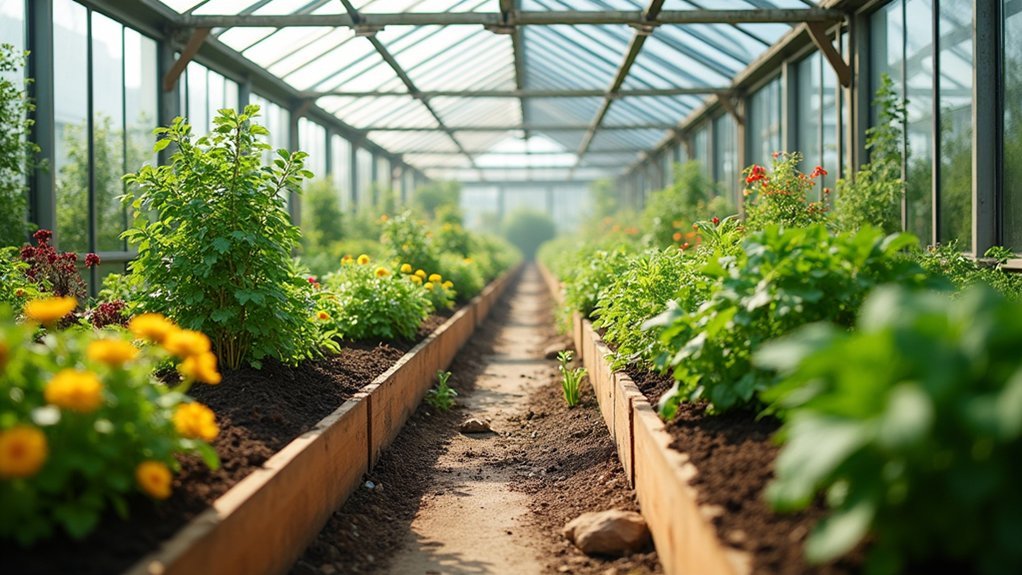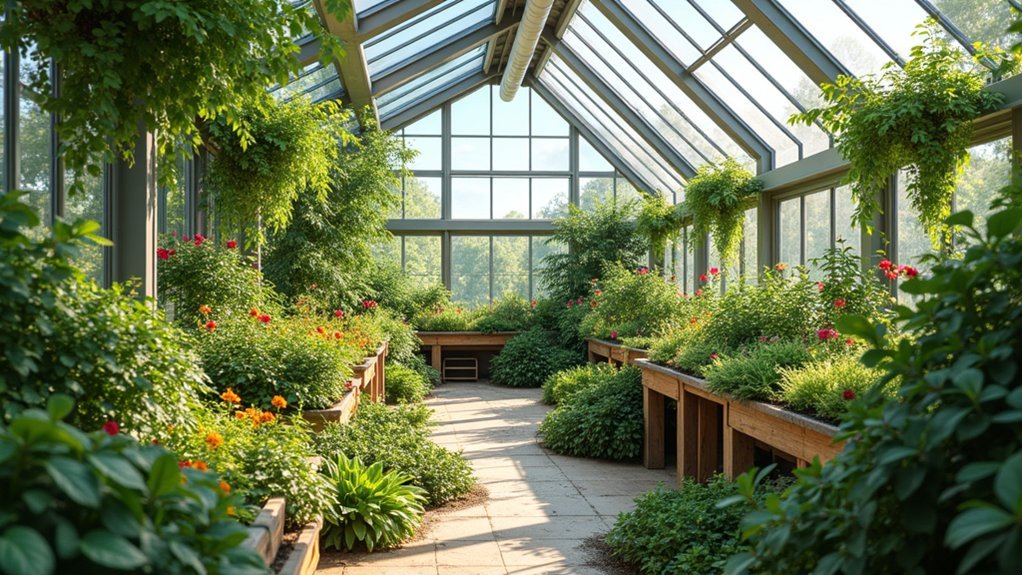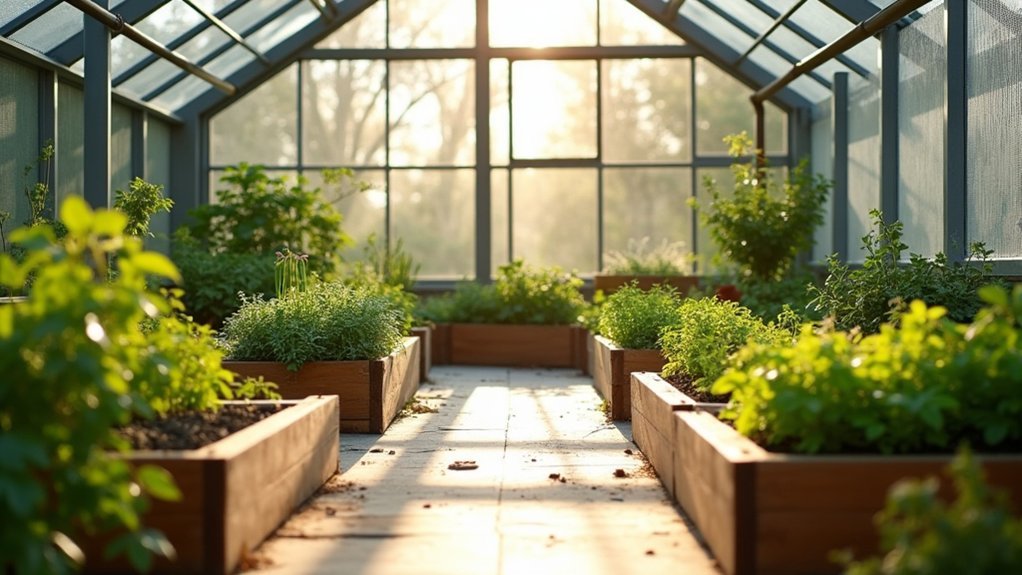For disabled gardeners, three outstanding greenhouse systems include raised bed systems with 28-34 inch heights and self-irrigation for wheelchair users, modular vertical gardens that minimize reaching while maximizing space, and therapeutic sensory designs with adjustable workstations. You’ll appreciate the rolling wheels for repositioning, ergonomic planters to reduce strain, and non-slip surfaces for safety. These accessible options transform gardening from challenging to fulfilling, offering independence regardless of physical limitations.
Raised Bed Greenhouse Systems With Self-Irrigation for Wheelchair Access

When designing greenhouse systems for disabled gardeners, raised beds with self-irrigation offer remarkable accessibility for wheelchair users. The ideal height ranges between 28-34 inches, allowing you to roll underneath with a forward approach design while maintaining comfortable reach.
You’ll appreciate beds with no more than 2 feet of width from side to center, ensuring every plant remains within reach. Choose durable materials like cedar that provide structural support for leaning. The integration of self-irrigation systems reduces maintenance demands while improving water efficiency.
For maximum accessibility, look for ADA-compliant designs with ample clearance space and stability features. Many superior options come with rolling wheels for easy repositioning to optimize sunlight exposure throughout the seasons. These systems can be modular and adaptable for indoor/outdoor use.
Beyond practicality, these accessible gardens promote independence, reduce physical strain, and provide therapeutic benefits while creating an inclusive gardening environment.
Modular Vertical Garden Systems With Adapted Tools for Limited Mobility
Modular vertical garden systems offer four key advantages for gardeners with limited mobility: maximized growing space, reduced physical strain, customizable arrangements, and easier maintenance. These systems incorporate ergonomic planters and built-in drip irrigation to minimize watering effort while optimizing your available space. With modular grid systems, you can create customizable environments for herbs, salad greens, and vining plants that suit your specific needs.
| Feature | Benefit | Implementation |
|---|---|---|
| Built-in irrigation | Reduces watering tasks | Automated drip systems |
| Ergonomic design | Minimizes reaching/bending | Accessible planter heights |
| Modular components | Customizable to your needs | Reconfigurable sections |
You’ll appreciate how these systems combine functionality with psychological benefits. The sustainable materials like recycled aluminum and cedar guarantee durability while the vertical arrangement improves air quality and reduces noise pollution. With user-friendly interfaces and lightweight components, you can enjoy gardening without overexertion, creating a therapeutic environment that enhances your wellbeing through increased plant interaction.
Therapeutic Sensory Greenhouse Designs With Accessible Workstations

Therapeutic sensory greenhouse designs create multidimensional gardening experiences that extend beyond the practical benefits of vertical systems.
These environments stimulate multiple senses while accommodating various mobility needs, creating spaces where you’ll find both healing and joy. Many designs incorporate familiar plants and dynamic arrangements that evoke nostalgic memories for users, especially those with dementia.
Your greenhouse can become a sensory haven with:
- Adjustable-height workstations that accommodate both standing and seated gardening
- Strategic placement of aromatic plants near waist-level planters for sensory stimulation
- Water features that provide calming sounds and attract wildlife
- Textured pathways that aid navigation while stimulating tactile awareness
The ideal therapeutic greenhouse incorporates non-slip surfaces, ample seating with supportive rails, and climate controls for year-round comfort.
These thoughtful designs don’t just make gardening possible—they transform it into a thorough therapeutic experience that boosts mental health and fosters community connections.
Frequently Asked Questions
What Is the Average Cost to Fully Install an Accessible Greenhouse?
You’ll spend $13,500-$20,000 for a fully accessible greenhouse installation. This includes the base cost ($11,000 average) plus accessibility features like ramps, automatic doors, and adjustable workstations that increase overall expenses.
How Do Accessible Greenhouses Perform in Extreme Weather Conditions?
Accessible greenhouses perform excellently in extreme weather, offering you stability with their flexible membranes and aluminum frames that withstand hurricane winds. They’ll maintain comfortable internal environments through automated climate controls regardless of outside conditions.
Can These Systems Be Retrofitted to Existing Greenhouse Structures?
Yes, you can retrofit existing greenhouses for accessibility by widening pathways, installing raised beds with wheelchair clearance, adding vertical growing systems, and customizing workstations. You’ll need to guarantee structural supports accommodate these modifications.
What Ongoing Maintenance Is Required for Accessible Irrigation Systems?
You’ll need to perform monthly leak checks, clean sprinkler heads, calibrate controllers seasonally, guarantee electrical safety, and schedule annual professional maintenance. Don’t forget seasonal tasks like winterization and adjusting watering schedules based on weather changes.
Are There Grants or Funding Options for Disabled Gardeners?
You’ll find several grants available including the National Garden Bureau’s therapeutic program, Gardening with Disabilities Trust (UK), USDA grants, and community garden funding. Local authorities may also offer support for garden adaptations.
In Summary
You don’t need to give up gardening because of mobility challenges. Whether you choose raised beds with self-irrigation, modular vertical systems with adapted tools, or therapeutic sensory designs with accessible workstations, there’s a greenhouse option that works for your specific needs. Embrace these accessible solutions and you’ll continue enjoying the therapeutic benefits of nurturing plants regardless of physical limitations.





Leave a Reply